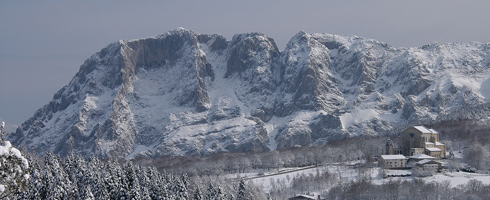Parque Natural de Urkiola · Ayuntamiento de Abadiño
Situación
Menú principal

Against a backdrop of beeches, ashes and birches, the Sanctuary of the Saint Anthonys of Urkiola rises up at the top of Urkiola and can be reached along the main road from Durango to Vitoria. At 750 m above sea level, the church stands at the very centre of the provinces of Bizkaia, Gipuzkoa and Alava, and is within the Abadiño municipal district in Bizkaia. It is 2 kilometres from the border with Alava and 5 km from Gipuzkoa. The church is 40 km from the capital of Bizkaia, 30 km from Alava’s and 90 from Gipuzkoa’s.
Curiously, the sanctuary is located at the geographical centre of the Basque Country and its roof is the watershed of two seas, the Bay of Biscay and the Mediterranean. In the latter case, the rainwater runs down into the River Ebro that winds its way over the Alava plain towards the sea. It is framed to the north and east by the Duranguesado mountains, whose highest peak is Anboto, and by Mounts Eskubaratz and Saibi to the West and the Arangio mountain range to the South. Its magnificent location makes its popular with tourist and a series of services, including accommodation, shelters and restaurants, have been set up near to the Sanctuary to make the visitors' stay more pleasant.
The history of Urkiola Sanctuary is closely linked to the history of Christianity in this region. Christianity began to spread through Bizkaia from the 9th to the 11th century. It is thought that the preachers came in through Alava and made their way along the Roman roads . One of those roads went through Urkiola, which explains why the Duraguesado was one of the most important and influential centres of Christianity at that time.
Many chapels were built on ancient pagan sites, such as caves and springs, and the most popular sanctuaries were built at Aralar and Anboto, believed to be the sacred place where Mari, the main figure of Basque Mythology, dwelt.
It is not known exactly how old the Sanctuary is, as the only ancient documents that we have only refer to it as being very old and do not give a precise date. Urkiola was obviously the ideal spot for one of the earliest churches to be built as it was used by many shepherds to graze their flocks and herds, along with the fact that it was already a holy place and the existing road provided easy access.
Some chroniclers venture that work began on the Urkiola church in the 8th or 9th centuries. In 1567, the Sanctuary already had a hospital and a house that provided an income of 61 ducats, which was used to support the church and hospital. Saint Anthony Abad and Saint Anthony de Padua are worshipped at the sanctuary, but old Saint Anthony Abad has been eclipsed to the extent that the Sanctuary is even popularly known as "Sanctuary of San Antonio".
It is a huge building. The only entrance is up the magnificent steps. The altar is surrounded by twenty-one cubic stones. The sanctuary’s garden contains symbols of life in Bizkaia: an anchor symbolising seafaring Bizkaia; agricultural Bizkaia by a typical Basque spade and industrial Bizkaia by a stone turbine from an old smithy. A large stone stands opposite the Sanctuary. It is a meteorite and is thought to have special powers: folklore has it that any girl of marriageable age who walks around it several times will soon find a husband.
2006 - 2007 © Anteiglesia de Abadiño Town Council - All rights reserved